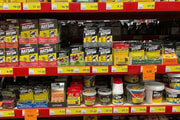Australians Beware: The Deadly Substance Lurking in the Bush That No One Is Talking About
By
Gian T
- Replies 0
In the vast and rugged landscapes of Australia, a silent but deadly battle is being waged. It's not just the harsh elements or the venomous creatures that pose a threat, but a controversial substance known as 1080 bait. This poison, while lethal, plays a critical role in protecting Australia's unique ecosystem, yet it's a topic that often goes undiscussed among the general public.
1080 bait, or sodium fluoroacetate, is a potent toxin used to control invasive species that threaten Australia's native wildlife and agricultural livelihoods. The substance is derived from a naturally occurring toxin found in certain native Australian plants, which means many indigenous species have developed a tolerance to it. However, for invasive predators like foxes, feral cats, and rabbits, 1080 can be fatal.
The use of 1080 has become a divisive issue, with growing opposition from those concerned about its impact on the environment and non-target species. Gillian Basnett from the Centre for Invasive Species Solutions has been vocal about the necessity of 1080, stating, 'It’s the thin green line we have that protects our threatened animals. Without it, we are choosing cats and foxes, rabbits and pigs over our native wildlife, and that is not a choice I would make.'
Australia is facing an extinction crisis, with more mammal species lost here than in any other continent. Predation by invasive species is a significant factor in these extinctions. Gillian warns that without 1080, the situation would worsen dramatically, leading to the loss of even more native species.
However, recent research by Deakin University has raised concerns about the potential harm to non-target animals, such as native mice species, which have been found to dig up and consume the baits intended for predators. This has led to a misunderstanding that 1080 indiscriminately kills native wildlife, a notion that Gillian and other experts are keen to dispel.
Despite the controversy, 1080 remains one of the most effective tools in managing invasive species. It is environmentally sustainable, does not accumulate in the environment, and is highly effective against the target species. Alternatives, such as the development of viruses to control invasive populations, are being explored but could take decades to become viable.
The debate over 1080 also extends to the management of dingoes or wild dogs. While protected in some states, they are considered pests in others due to their impact on livestock. The complexity of dingo genetics has further muddied the waters, with some arguing that they should not be targeted due to their long history in Australia. However, the reality is that dingoes can also pose a threat to vulnerable wildlife in certain areas.
For pet owners, the message is clear: it is their responsibility to keep their pets safe. Baiting programs are signposted, and it is crucial to heed these warnings and not take pets into baited areas. Gillian advises those travelling or camping to research and ensure that the areas they visit are safe for their pets.
The use of 1080 is a contentious but necessary evil in the fight to preserve Australia's biodiversity. It's a complex issue that requires a delicate balance between the welfare of native species and the ethical considerations of using poison as a control method. As Australians, we must stay informed and support land managers in their efforts to protect our precious wildlife while also taking personal responsibility for the safety of our pets.

We at the Seniors Discount Club invite you to share your thoughts and experiences on this topic. Have you encountered 1080 bait in your travels or local area? Do you believe there's a better way to manage invasive species? Let's have a conversation about the challenges and solutions in preserving Australia's unique ecosystem.
1080 bait, or sodium fluoroacetate, is a potent toxin used to control invasive species that threaten Australia's native wildlife and agricultural livelihoods. The substance is derived from a naturally occurring toxin found in certain native Australian plants, which means many indigenous species have developed a tolerance to it. However, for invasive predators like foxes, feral cats, and rabbits, 1080 can be fatal.
The use of 1080 has become a divisive issue, with growing opposition from those concerned about its impact on the environment and non-target species. Gillian Basnett from the Centre for Invasive Species Solutions has been vocal about the necessity of 1080, stating, 'It’s the thin green line we have that protects our threatened animals. Without it, we are choosing cats and foxes, rabbits and pigs over our native wildlife, and that is not a choice I would make.'
Australia is facing an extinction crisis, with more mammal species lost here than in any other continent. Predation by invasive species is a significant factor in these extinctions. Gillian warns that without 1080, the situation would worsen dramatically, leading to the loss of even more native species.
However, recent research by Deakin University has raised concerns about the potential harm to non-target animals, such as native mice species, which have been found to dig up and consume the baits intended for predators. This has led to a misunderstanding that 1080 indiscriminately kills native wildlife, a notion that Gillian and other experts are keen to dispel.
Despite the controversy, 1080 remains one of the most effective tools in managing invasive species. It is environmentally sustainable, does not accumulate in the environment, and is highly effective against the target species. Alternatives, such as the development of viruses to control invasive populations, are being explored but could take decades to become viable.
The debate over 1080 also extends to the management of dingoes or wild dogs. While protected in some states, they are considered pests in others due to their impact on livestock. The complexity of dingo genetics has further muddied the waters, with some arguing that they should not be targeted due to their long history in Australia. However, the reality is that dingoes can also pose a threat to vulnerable wildlife in certain areas.
For pet owners, the message is clear: it is their responsibility to keep their pets safe. Baiting programs are signposted, and it is crucial to heed these warnings and not take pets into baited areas. Gillian advises those travelling or camping to research and ensure that the areas they visit are safe for their pets.
The use of 1080 is a contentious but necessary evil in the fight to preserve Australia's biodiversity. It's a complex issue that requires a delicate balance between the welfare of native species and the ethical considerations of using poison as a control method. As Australians, we must stay informed and support land managers in their efforts to protect our precious wildlife while also taking personal responsibility for the safety of our pets.
Key Takeaways
- There is growing controversy and opposition to the use of 1080 bait in Australia due to concerns over its impact on native wildlife and pet safety.
- is considered vital for controlling invasive species and protecting threatened native animals, according to Gillian Basnett from the Centre for Invasive Species Solutions.
- Recent research suggests that 1080 bait intended for predators like foxes and cats is also being ingested by non-target species, such as native mouse species.
- While acknowledging the challenges of using poison for eradication, experts like Gillian argue for the necessity of 1080 in Australia's environmental management and urge the public to support its use while being responsible for pet safety during baiting programs.
Last edited:








